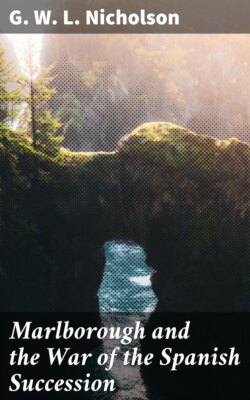Читать книгу Marlborough and the War of the Spanish Succession - G. W. L. Nicholson - Страница 8
На сайте Литреса книга снята с продажи.
The Coalition Against Louis XIV
ОглавлениеTable of Contents
On reaching The Hague in July Marlborough at once entered into negotiations for a last-minute settlement with France and Spain. That having failed, he began the reconstruction of a Grand Alliance against Louis XIV. King William remained in the background, wisely leaving the Earl to treat with the ambassadors from the various courts of Europe. The experience gave Marlborough a valuable insight into European affairs from the continental point of view. What he now learned in the field of grand strategy was to keep him from ever contenting himself with the popular belief "that naval operations against Spanish colonies and treasure-ships were the chief part of all that England need do to bridle the ambition of Louis."[7] Deliberations were completed by the beginning of September, and on the 7th Marlborough signed the main treaty, by which the Empire, Holland and England agreed to unite in imposing their territorial demands upon France and Spain. According to these Philip V would rule Spain and the Indies, but the French and Spanish crowns should in no circumstances become united. In return for this recognition of Philip, Milan, the two Sicilies and the Spanish Mediterranean islands were to go to the House of Austria. The disposition of the Spanish Netherlands, in which Dutch and Austrian interests conflicted, was purposely left indefinite—they were to "serve as a dyke, rampart and barrier to separate and keep off France from the United Provinces". A clause in the treaty guaranteed England and Holland the same commercial privileges with Philip V's territories as they had enjoyed under his predecessor, at the same time prohibiting French ships from trading with the Spanish Indies. The treaty expressly set down the number of troops that each of the principals would put into the field to enforce these objectives. The Empire agreed to furnish 66 regiments of foot and 24 of horse (82,000 men), Holland 82 foot and 20 horse (100,000) and England 33 foot and seven horse (40,000).
Subsequent agreements made individually with Prussia, Hanover and other German principalities swelled the numbers of the international army which was forming against Louis XIV—these minor powers, many of which maintained forces far larger than the size of their territories warranted, pledging their contingents in return for English and Dutch subsidies. By the exercise of skilful diplomacy and the outlay of large sums of money Marlborough secured the neutrality of the young Charles XII of Sweden, who had just won an exhilarating victory over Russia and was being assiduously wooed by Louis, with whom he was traditionally far more inclined to side than the Emperor. With Sweden thus restricted her nervous neighbour Denmark felt safe in supplying her quota of troops to the Grand Alliance.
An enthusiastic English Parliament quickly ratified the treaties which Marlborough had negotiated, and preparations went forward rapidly to put the country on a war footing. England had to raise 58,000 men—40,000 seamen for her fleet and 18,000 soldiers. The remaining 22,000 troops required to meet her commitment to the Grand Alliance would be foreign soldiers in English pay. Then on February 20, 1702 King William was thrown from his horse while taking exercise and broke his collarbone. Complications set in and in two weeks he was dead. On March 8 Anne, younger daughter of James II, ascended the throne. Her friendship with Sarah Churchill at this stage was never more sincere. During the Churchills' long service in her father's household Anne had been accustomed to turn to them for guidance in almost all she did. Now that she was queen her reliance upon Marlborough was greater than ever; for the next five years the management of not only England's military ventures on the Continent but also of the country's domestic affairs was to rest largely in the Duke's hands.
